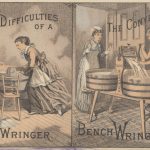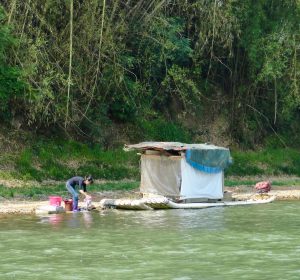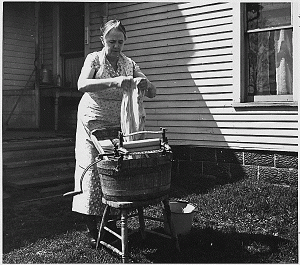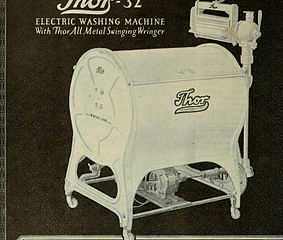We don’t think much about washing clothes. Which is to say most of us don’t think it’s an enjoyable occupation. This is true whether we take our washing to the laundromat, or have the luxury of a home machine. For some bizarre reason, every time I use the washing machine, I think it’s some kind of miracle. Dirty clothes in; clean clothes out. I don’t have to take my clothes to the river or haul water to boil over a fire. Less than one hundred years ago, women in rural America, lacking both electricity and running water, did this every Monday.
Robert Caro, famous for his multi-volume biography of Lyndon Johnson, wrote about wash day in Texas during the 1930s. First, pump water from the well. Next, cut wood and lay a fire outside. Boil vat of water. Now, it’s time to do the laundry.
Scrub clothes in a tub with lye soap. Move the clothes around with a paddle. Shift soapy wash to a rinse tub. An average tub held about eight gallons of water.
Another method, illustrated here used a smaller tub. But clothes still had to be scrubbed on a washboard and eventually drawn through a wringer to remove as much water as possible before hanging the wet laundry on a line.
a smaller tub. But clothes still had to be scrubbed on a washboard and eventually drawn through a wringer to remove as much water as possible before hanging the wet laundry on a line.
In 1933 women with access to piped water and electricity could utilize the THOR-32 electric washing machine. It had a revolving, reversing cylinder to “lift and dip the clothes through active, soapy water.” And it featured a “wonderful metal swinging wringer.”
In the 21st century, we take washing machines for granted. Mine adds the soap, washes, rinses, spins and produces clothes that are practically dry already. And, yes, I do have a dryer to complete the process, as well as a clothesline.
This amazing machine rewards us with the gift of time. It also uses energy produced by electricity or gas. Both affect our environment. It’s a trade off.
One of my loyal readers is an economics professor. Last week he sent me a link to a talk Hans Rosling presented at TEDWomen2010. From an analytic perspective, Rosling explains the impact such a simple machine has had on our world and points out the thousands of people, like the woman in the first photo, who still lack even this labor saving device. The video is nine minutes long and well worth your time.
Hans Rosling. “The Magic Washing Machine.”
???
Photo of woman washing on banks of the Li River, Yanghshuo, China by Author.
Remaining illustrations in Public Domain, Wikimedia Commons.
REA Woman Works Washboard.
Bailey Wringing Machine.
THOR 32 Electric Washer, 1933.
Clay Coppedge.”LBJ and the Sad Irons.” TexasEscapes.com.

Sandra Wagner-Wright holds the doctoral degree in history and taught women’s and global history at the University of Hawai`i. Sandra travels for her research, most recently to Salem, Massachusetts, the setting of her new Salem Stories series. She also enjoys traveling for new experiences. Recent trips include Antarctica and a river cruise on the Rhine from Amsterdam to Basel.
Sandra particularly likes writing about strong women who make a difference. She lives in Hilo, Hawai`i with her family and writes a blog relating to history, travel, and the idiosyncrasies of life.




